THE EVOLUTION OF jewelry store design has been reflected in the pages of INSTORE, particularly in the America’s Coolest Stores contest, since the magazine was founded 20 years ago. Today lighter and brighter customer-centric interiors with residential vibes and in-store technology are increasingly the norm among the coolest stores we see.
Store designer Jesse Balaity of Balaity Property Enhancement says jewelers must compete for customers’ time before competing for their dollars by creating spaces that encourage exploration and lingering.
“If the coffee shop or national merchant next door offers a more enticing space, then customers may not even notice the jeweler,” he says. “I believe the more successful jewelers take the time to understand customer expectations and craft spaces that meet or challenge their modern definitions of luxury.”
Andrea Hill of Hill Management Group says customers want to feel safe, welcome, comfortable and stimulated, and so jewelers need to find a way of “being luxury” without being formal. Hard cases, dark colors and static pathways all signal formality and protection against loss. “Channeling those older forms of luxury tends to identify a brand as being older, less hip and out-of-touch,” she says. “Today, luxury brands are trying to convey intimacy, graciousness, belonging and purpose. How they do it is different for each brand because they are interpreting these concepts relative to their own brand messaging and identity.”
Here are 10 ways stores are updating their form and function to be more accessible.
Advertisement
Side-By-Side
Selling Encourages
Conversation
There’s a diversity in case size as well as floor and ceiling treatments and less reliance on a ring of same-sized showcases in the center of the store. New modular case configurations allow associates to be on the same side as shoppers, making the process more friendly and casual. Layouts can loosen up, too, becoming less grid-like and more free-flowing or divided into distinct function-driven areas. Kate Peterson of Performance Concepts says the owner should be prepared, when transitioning to side-by-side selling, to completely retrain the sales team, and not only about security concerns. “It’s an entirely different interaction with the customer that requires the development of a more engaging, more collaborative sales approach,” she says.
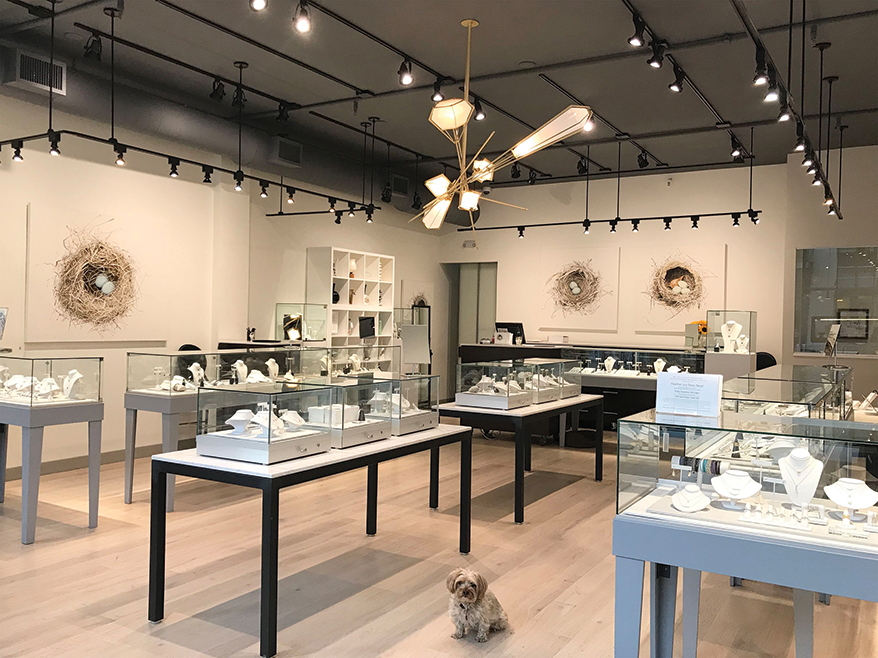
Art + Soul in Boulder, CO, is set up for side-by-side sales consultations.
Privacy Is Not Just
For VIPs Anymore
In a change hastened by pandemic considerations, jewelers are meeting their clients in private spaces, whether to discuss engagement rings or ponder other significant purchases. Late last year in New Orleans, MS Rau unveiled an 8,500-square-foot jewelry boutique designed by architect Jonathan Tate and Truitt Brand Design. The centerpiece is a glass-walled consultation room known as the Crystal Palace, well suited for clients to examine rare colored diamonds and such diverse vintage celebrity vintage finds as Prince’s stage jewelry and Wallace Simpson’s brooch. The VIP space is equipped with light-changing technology, while its showcases are fitted with glass that slides out of the way, receding into the body of the case, with the touch of a key card.
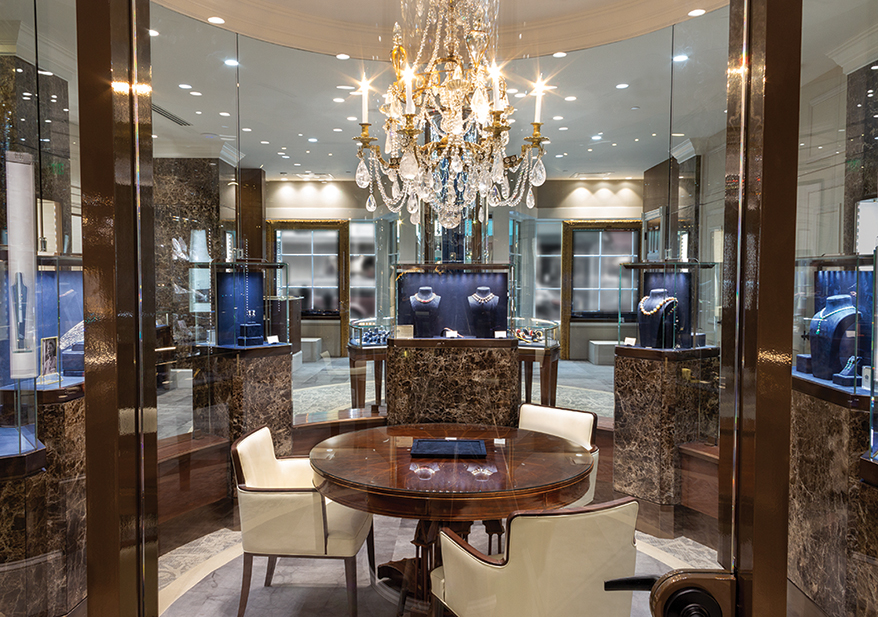
MS Rau’s glass-walled space inside the New Orleans jewelry boutique offers a private spot for high-level chats.
Selling Custom Design
Around the Table
Collaboration extends to the custom design process, leading to an emphasis on design desks, tables, counters and niches. Jewelers often employ CounterSketch software while their clients can watch and make suggestions, bringing them into the process. Interior designer Leslie McGwire has integrated tech bars into store designs, inviting customers to view jewelry on computers. But even if the jeweler is working with pencil and paper, showing a portfolio, or laying out materials, these activities may take place on expansive design tables that become focal points. “It is truly amazing how this has become popular,” says Ruth Mellergaard of GRID/3 International. “I think these tables remind us, subconsciously, of good family events at the dining room table or the kitchen island.”
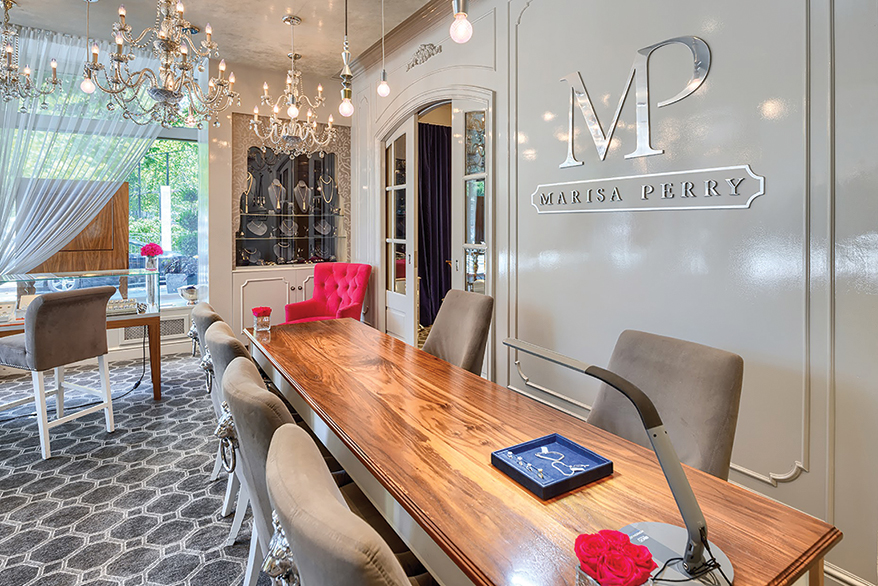
Marisa Perry Atelier of New York makes a design table a focal point of the showroom.
Elevating the
Art of Hospitality
It’s important to stop treating seating as an afterthought, Balaity advises. Think of a lounge or bar as not just a necessary sacrifice of showcase space, but as an amenity that demonstrates your commitment to the customer experience. “You are seeing so many beverage bars being included in the final design of the store,” observes Keely Grice of Grice Showcase. “Many are even including lounge areas to sit with their clients and enjoy the moment during the sale or while waiting for the repair to be brought to them.” McGwire says store owners she’s worked with serve gourmet coffee in the morning and beer, wine or cocktails in the afternoon.
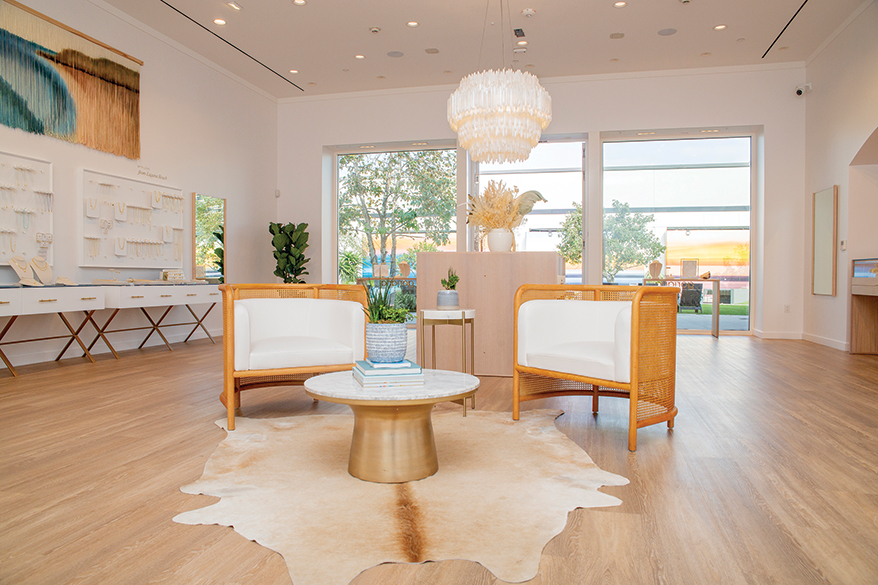
Gorjana’s newest Manhattan Beach, CA, location reflects a proclivity for a white and bright look.
A Light and Airy
Look Banishes
Formality
Mirroring residential interior design, jewelry stores are lightening up in many ways, employing cases without bases, for example, to create more visual white space. As for the color palette, creams, light taupes with mixed silver and gold metals are popular, says McGwire. “The overall design looks to create a more light and airy feeling.”
Jewelry designer Gorjana Reidel and her husband, Jason Griffin Reidel, own 25 Gorjana-branded jewelry stores around the country, all of which reflect a beach-cottage vibe. “Our No. 1 goal was how do we make it feel like you’re coming into our home,” says Gorjana. Mango wood finishes, blue Shibori accents and greenery all recall the brand’s Laguna Beach origins and complement the laid-back selling style.
Kate Peterson of Performance Concepts says the shift from “dark and heavy” (i.e., lots of wood, richly colored carpets, focal point light fixtures, etc.) to lighter and more minimalist, especially in higher-end stores, is a significant change that reflects a new concept of professionalism, which is all about the customer. “I think the evolution in store design reflects that perfectly. Lighter, airier spaces, less crowded displays, much better lighting options, more functional/sensible (and often sustainable) materials and more inviting storefronts are all hallmarks of successful ‘next generation’ stores.”
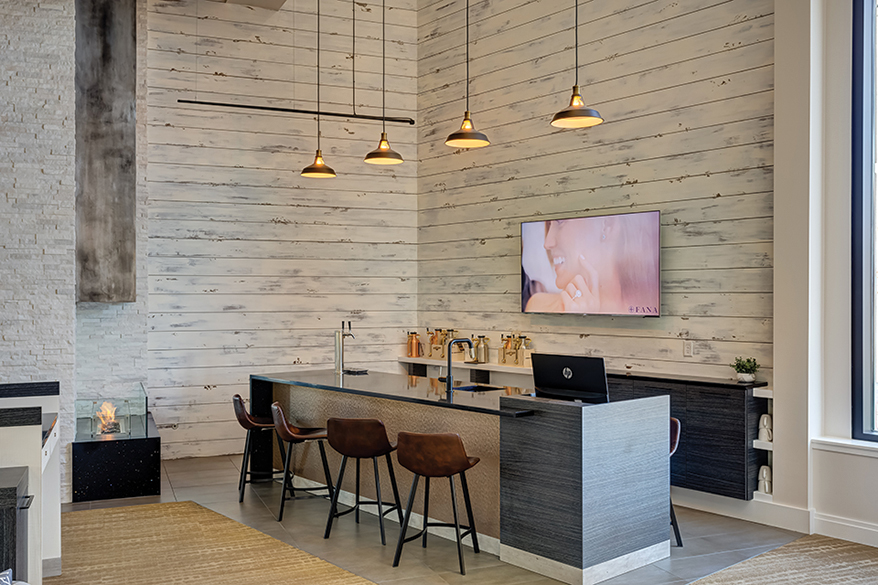
At Carter’s Jewel Chest in Mountain Home, AR, designed by Balaity Property Enhancement, a beer tap is integrated into the bar.
A Window on the
Shop: “Seeing How
the Sausage Is Made”
Shops are increasingly visible through a window or doorway or integrated into the showroom itself. Clients may be invited to tour the shop, watch bench jewelers set their diamonds, and make their wedding bands or cast their engagement rings. “We used to believe that customers did not want to see how the sausage is made, that a shop that was anything but pristine could detract from the fancy jewelry buying experience,” Balaity says. “Two things have changed. First, the demand for full custom design exploded, from sketches to casting to a unique product no one else can show off on Instagram. Nothing demonstrates a jeweler’s custom abilities like the shop itself.” Second, a visible shop plays into the experiential aspect of modern retailing, rather than detracting from the presentation. “Essentially, customers ARE interested in how the sausage is made,” he says.
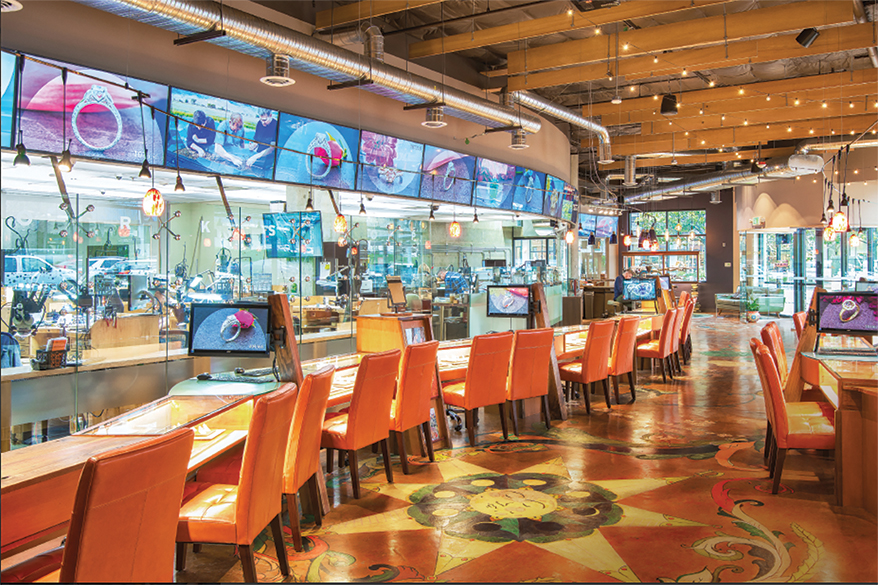
At the vibrant Green Lake Jewelry Works in Bellevue, WA, designed by owner Jim Tuttle, customers can see the shop through a floor to ceiling glass wall in the ultimate expression of transparency.
LED Lighting Can
Brighten A Mood As
Well As A Showcase
Advances in LED fixture design are freeing for store design, Balaity says. “We now have access to a tremendous variety of fixtures at different levels of power, beam spread, and color temperature for every specific little application within the store.”
The biggest change, though, relates to the illumination of non-jewelry areas within the store. “The old strategy of bright and even illumination over a sea of showcases feels dated,” he says. “It’s unwelcoming to the customer who is accustomed to great retail spaces even for lower price point products. Now we create luxurious lounge spaces, bars, game areas, and patios. We use decorative and indirect lighting to create a mood in these spaces, which is complementary to the jewelry areas.” Randy Mitchum says choosing recessed LEDs for his store in Ozark, MO, rocked his world. “If you worked in a store with fluorescent and halogen lights and all of a sudden it’s so much brighter, you can go into shock,” he says. “People talk about how amazing the lighting is.”
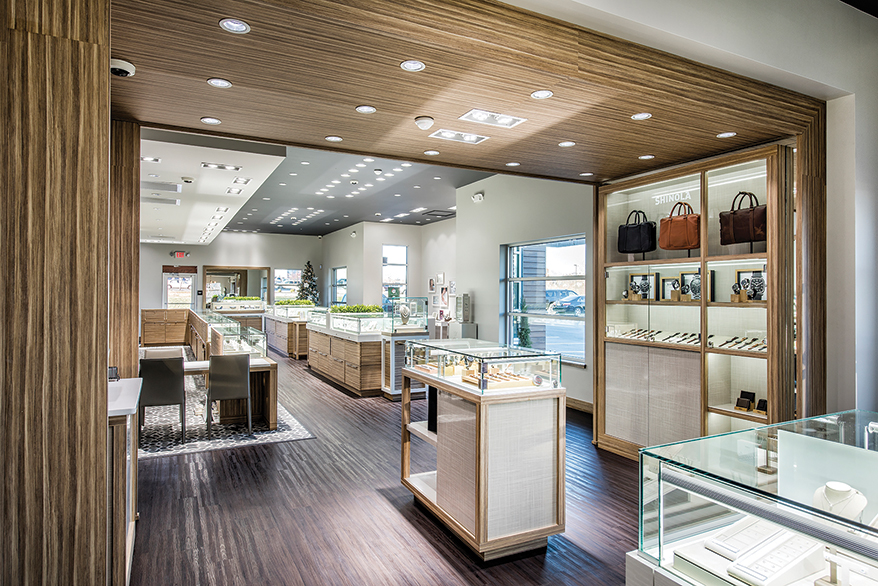
At Mitchum Jewelers in Ozark, MO, designed by Balaity Property Enhancement, LED lights elevate the look.
Residential Influences
Set Shoppers At Ease
Balaity’s clients Barry and Laura Cole of Bere Jewelers in Pensacola, FL, included a full bar area, an outside seating area and a lounge area, too, in their newest location. “When you walk in and see Barry in this environment, it looks like you’re seeing him in this large living room,” Balaity says. “It really is the owner’s personality that melds with the design and makes it a retail experience.”
McGwire says decorative lighting, accessories, including art, and the use of color and texture all add visually interesting layers that create residential vibes.

London Jewelers in Manhasset, NY, designed by Nelson Worldwide, balances comfort and elegance.
Personality Plus:
The Joyful Argument
For Bold Color
Creative designers are taking dramatic measures to ensure jewelry shopping is fun and inviting, while expressing the brand’s personality. Bold color choices are one way to achieve this goal.
Fiat Lux is a fine jewelry boutique and piercing parlor in San Francisco. Owner Marie McCarthy’s first Fiat Lux location had a punk rock vibe suited to the neighborhood. But for her second location in a different part of town, McCarthy opted for what she calls “joyful maximalism.”
Interior designer Noz Nozawa, whose focus is primarily residential, concentrated on creating a homey experience, as if the shopper were in the living room of a friend who just happened to have a lot of fabulous jewelry. “This is often a very expensive purchase for something that is tiny,” she says. “How do you address the experience so that it is not intimidating?”
An octagonal, custom designed and fabricated burgundy jewelry case is at the center of things, the color inspired by lighter sapphires and deeper rubies, and the shape influenced by emerald-cut gemstones.
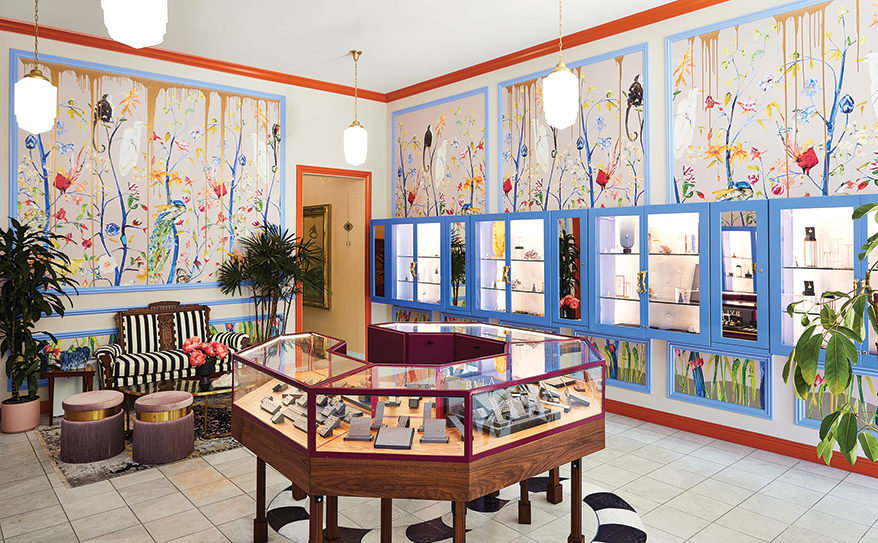
Noz Nozawa used color and creativity in the design of Fiat Lux in San Francisco to achieve owner Marie McCarthy’s goal of joyful maximalism.
Decorative painting by Caroline Lizarraga includes a black and white snake coiled on the floor and portraits of the jewelry itself. Most dramatically, expensive wallpaper is in effect “ruined” by dripping gold dust and resin onto it. “To have lovely wallpaper on the walls and make it very prominent and then technically ruin it is a nod to the punk rock heritage of the brand origin story,” says Nozawa. Existing wall cases were painted and dressed up with brass-tiger hardware; each touchpoint is surprising and exciting.
“Color is a powerful meter to amp up when it comes to retail and jewelry,” Nozawa says. “A lot of times, I think people live very much in the brain and ignore the senses. You have to bring color in if what you want to convey is joy, to be transported into this vibrant happy energy, where the jewelry is what makes you happy.”
Advertisement
A Natural Affinity For
Bringing in Daylight
In 2017, the Yeko family of Janesville, WI, built a new store under the design direction of Leslie McGwire. After 30 years in a windowless mall, they were ready to see the light with 270-degree views. The store has more than 2,000 square feet of glass curtain walls, with more than half of that glass tilted out to span a height of 24 feet, floor to ceiling.
Ruth Mellergaard of GRID/3 International says daylight shows off diamonds and supports a movement toward natural environments. “This human-nature affinity is called biophilia, and we are seeing more interest in adding plants to stores, even green walls, since they improve the air quality in indoor spaces.”
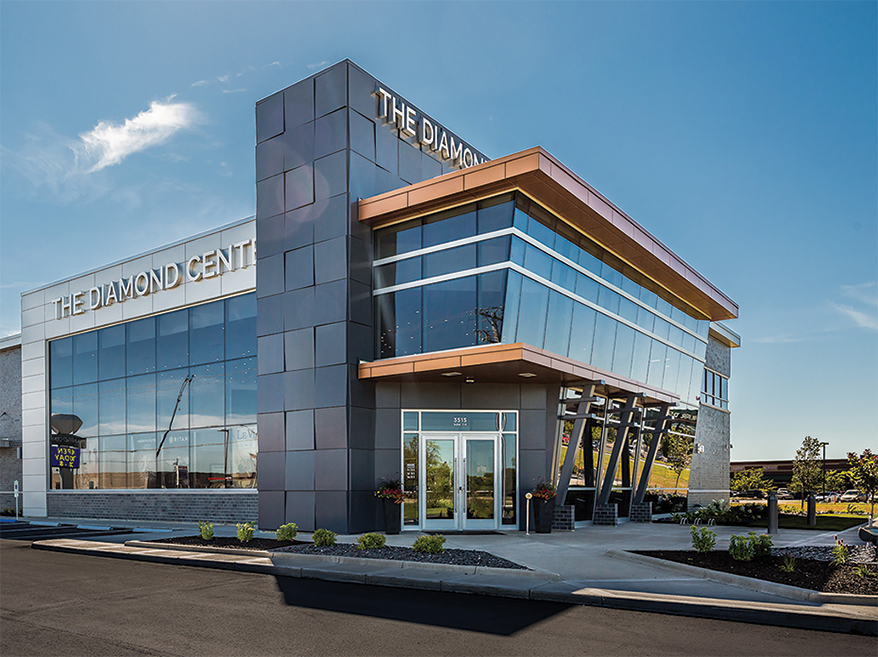
The Diamond Center in Janesville, WI, boasts 270-degree views of the great outdoors.